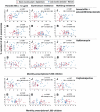Seasonality of antibiotic-resistant streptococcus pneumoniae that causes acute otitis media: a clue for an antibiotic-restriction policy?
- PMID: 18419528
- PMCID: PMC2652754
- DOI: 10.1086/528995
Seasonality of antibiotic-resistant streptococcus pneumoniae that causes acute otitis media: a clue for an antibiotic-restriction policy?
Abstract
Background: It is unclear whether reducing antibiotic prescriptions can reduce rates of resistance once resistance becomes prevalent. We attempted to determine whether reduced antibiotic consumption, which is observed yearly in children during the warm season, is associated with a reduction in antibiotic resistance in pneumococcal acute otitis media (AOM).
Methods: Antibiotic prescriptions and resistance were measured prospectively during 1999-2003 in 2 demographically distinct populations: Jewish and Bedouin children (aged <5 years) in southern Israel. Associations were assessed using seasonally clustered logistic regression models.
Results: The study included 236,466 prescriptions and 3609 pneumococcal isolates. Prescription rates decreased during the warm months by 36% and 15% in Jewish and Bedouin children, respectively (P < .001 for the season). Among Jewish children, higher resistance rates were observed during the cold than the warm months (P < .001 for each antibiotic). This difference remained significant after adjustment for age, ethnic group, study year, history of antibiotic use, and serotype. The difference was not observed in Bedouin children.
Conclusions: Rapid seasonal decline in resistant AOM-causing pneumococci occurred only in Jewish children, among whom a marked prescribing seasonality was noted, and not in Bedouin children, among whom prescription was less seasonal. The rapid seasonal decrease in resistance associated with markedly reduced antibiotic use suggests that drug-resistant pneumococci may pay a fitness cost.
Figures






Comment in
-
Federal funding for the study of antimicrobial resistance in nosocomial pathogens: no ESKAPE.J Infect Dis. 2008 Apr 15;197(8):1079-81. doi: 10.1086/533452. J Infect Dis. 2008. PMID: 18419525 No abstract available.
-
It's time for a change in practice: reducing antibiotic use can alter antibiotic resistance.J Infect Dis. 2008 Apr 15;197(8):1082-3. doi: 10.1086/533450. J Infect Dis. 2008. PMID: 18419526 No abstract available.
-
The research agenda of the National Institute of Allergy and Infectious Diseases for antimicrobial resistance.J Infect Dis. 2008 Apr 15;197(8):1087-93. doi: 10.1086/533451. J Infect Dis. 2008. PMID: 18419527 Review.
-
Empiric use of antibiotics for treatment of respiratory infection and febrile seizures.J Infect Dis. 2008 Oct 1;198(7):1093-4. doi: 10.1086/591464. J Infect Dis. 2008. PMID: 18774887 No abstract available.
References
-
- Dagan R. Treatment of acute otitis media: challenges in the era of antibiotic resistance. Vaccine. 2000;19(Suppl 1):S9–16. - PubMed
-
- Low DE. Changing trends in antimicrobial-resistant pneumococci: it's not all bad news. Clin Infect Dis. 2005;41(Suppl 4):S228–33. - PubMed
-
- Felmingham D, Reinert RR, Hirakata Y, Rodloff A. Increasing prevalence of antimicrobial resistance among isolates of Streptococcus pneumoniae from the PROTEKT surveillance study, and comparative in vitro activity of the ketolide, telithromycin. J Antimicrob Chemother. 2002;50(Suppl S1):25–37. - PubMed
-
- Bruinsma N, Kristinsson KG, Bronzwaer S, et al. Trends of penicillin and erythromycin resistance among invasive Streptococcus pneumoniae in Europe. J Antimicrob Chemother. 2004;54:1045–50. - PubMed
MeSH terms
Substances
Grants and funding
LinkOut - more resources
Full Text Sources
Medical

